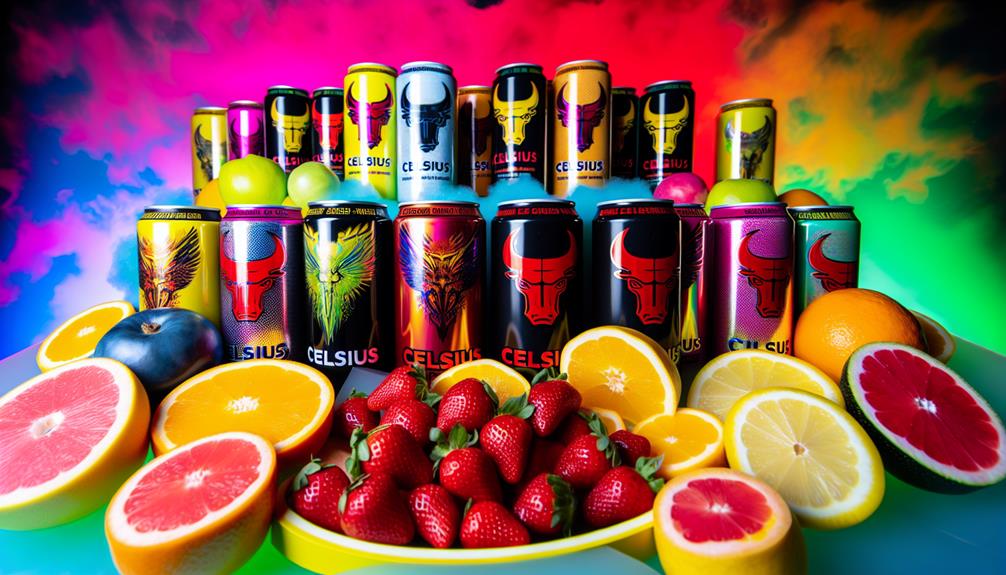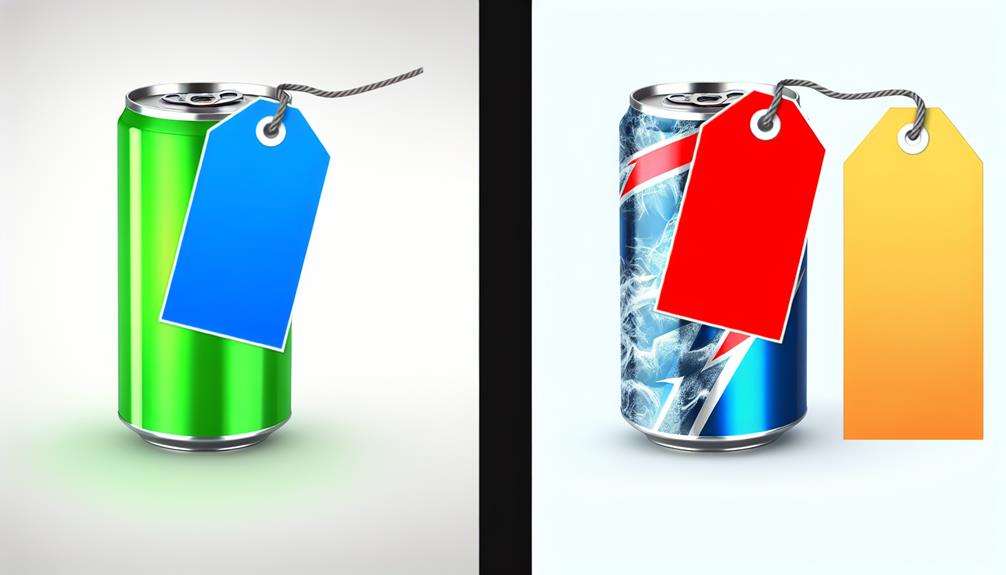Imagine you're at a gym, and you spot two friends—one sipping on a Celsius, the other downing a Red Bull. Each drink reflects a lifestyle choice, whether it's health-conscious or adrenaline-seeking. While Celsius caters to those invested in wellness with its natural ingredients, Red Bull draws in a crowd enthusiastic for an instant energy surge. But which option truly delivers on its promises? Understanding their differences may reshape how you view energy drinks and their impact on your routine.
Brand Overview
When it comes to energy drinks, both Celsius and Red Bull stand out as popular choices among consumers. Each brand has a unique history and marketing strategy that has contributed to its success. Red Bull, founded in 1984 by Dietrich Mateschitz and Chaleo Yoovidhya, revolutionized the energy drink market. Inspired by a Thai beverage called Krating Daeng, they refined the formula and launched Red Bull globally. Its bold branding and sponsorship of extreme sports helped cement its position as a leading energy drink.
Celsius, on the other hand, was established in 2004 and has positioned itself as a fitness-oriented alternative. Its marketing strategies focus on health-conscious consumers, emphasizing the drink's natural ingredients and functional benefits. Celsius promotes itself as a brand that not only energizes but also supports metabolism and exercise performance. This differentiates it from competitors like Red Bull, which primarily targets adrenaline-seeking consumers.
Both brands leverage digital marketing and social media to connect with their audiences. Red Bull's high-energy content and extreme sports sponsorships appeal to thrill-seekers, while Celsius uses fitness influencers and health-related content to attract a more health-focused demographic. Despite their different approaches, both brands have effectively captured significant market shares through their tailored strategies.
Ingredient Comparison
Both Celsius and Red Bull have distinct ingredient profiles that cater to their target audiences. When you look closely at what each drink contains, you'll notice significant differences in energy sources, nutritional value, and more. This comparison can help you make an informed choice based on your preferences.
Here's a breakdown of some key ingredients:
| Ingredient | Celsius | Red Bull |
|---|---|---|
| Caffeine Source | Green tea extract | Caffeine anhydrous |
| Natural Sweeteners | Stevia, erythritol | Sucrose, glucose |
| Herbal Extracts | Guarana, ginger | None |
| Carbonation Levels | Lightly carbonated | Highly carbonated |
| Calorie Count | 10 calories per can | 110 calories per can |
Celsius relies on natural sweeteners like stevia and erythritol, which may appeal to health-conscious consumers. In contrast, Red Bull uses traditional sugars, contributing to its higher calorie count. You'll also notice that Celsius incorporates herbal extracts such as guarana and ginger, which may enhance its perceived nutritional value.
On the other hand, Red Bull opts for a classic energy formula with a higher carbonation level and flavor enhancers that many find appealing. Ultimately, your choice might depend on your consumer preferences regarding ingredient sourcing and the importance of lower calorie counts. Understanding these differences can guide you to the energy drink that best suits your lifestyle.
Target Audience

When considering the target audience for Celsius and Red Bull, it is crucial to look at demographic preferences and lifestyle alignment. Celsius tends to attract health-conscious consumers seeking energy from natural ingredients, while Red Bull appeals more to a younger crowd focused on high-energy activities. Understanding brand loyalty trends can also reveal how these companies resonate differently with their respective audiences.
Demographic Preferences
Although energy drinks like Celsius and Red Bull target a variety of consumers, their demographic preferences reveal distinct audiences. Celsius appeals primarily to health-conscious individuals, particularly younger age groups—often ranging from 18 to 34—who prioritize fitness and wellness. Their marketing strategies heavily leverage social media influence, showcasing active lifestyles and fitness-related content to attract this demographic.
In contrast, Red Bull has carved a niche among a broader age range, including teenagers and young adults, often emphasizing high-energy consumption habits. Their marketing strategies include sponsorships of extreme sports and events, which resonate with individuals who value adventure and excitement.
Regional preferences also play a role; Celsius is gaining traction in urban areas where health trends are prominent, while Red Bull enjoys widespread recognition across various regions due to its established brand perception.
When it comes to activity levels, Celsius consumers tend to seek products that align with their fitness goals, making health and wellness a key purchase motivation. Red Bull consumers, on the other hand, may prioritize energy boost and performance, highlighting differing motivations behind their choices in energy drinks.
Lifestyle Alignment
Understanding the lifestyle alignment of Celsius and Red Bull helps clarify how each brand resonates with its respective audience. Celsius targets individuals who prioritize fitness integration and wellness trends, appealing to those who actively seek healthier energy habits. If you're someone who values clean ingredients and fitness-oriented choices, Celsius aligns well with your daily routines and activity levels, promoting a lifestyle that focuses on health and energy.
On the other hand, Red Bull captures the essence of social consumption and high-energy experiences. This brand often attracts those who thrive in dynamic environments—think parties, nightlife, and competitive events. If your lifestyle choices lean toward social gatherings and adrenaline-pumping activities, Red Bull might be more in tune with your energy needs.
Both brands reflect distinct brand values that cater to different segments of the market. Celsius emphasizes wellness and a balanced approach to energy, while Red Bull embodies excitement and adventure. Ultimately, your choice between these two brands hinges on your personal energy habits and how you navigate your lifestyle, whether through fitness or social engagement.
Brand Loyalty Trends
In traversing the energy drink landscape, brand loyalty trends reveal distinct preferences among Celsius and Red Bull's target audiences. Your consumer behavior is often shaped by brand perception, where Celsius markets itself as a healthier alternative, appealing to fitness enthusiasts. In contrast, Red Bull leverages its established brand identity and celebrity endorsements to capture a broader demographic.
Both companies employ unique marketing strategies. Celsius focuses on loyalty programs and community engagement, often fostering connections through experiential marketing events like fitness challenges. This approach resonates with consumers looking for brands that align with their active lifestyles. Meanwhile, Red Bull's advertising effectiveness hinges on high-energy campaigns and product placement in extreme sports, which appeals to thrill-seekers.
Social media influence plays an essential role in brand loyalty. Celsius harnesses platforms to promote its health benefits, while Red Bull capitalizes on its adventurous image, showcasing action-packed content. As you evaluate these brands, consider how their differing approaches to loyalty programs and community engagement shape your preferences. Ultimately, both brands have crafted compelling narratives that resonate with their respective audiences, reflecting the evolving landscape of energy drink consumer loyalty.
Health Benefits
When considering the health benefits of Celsius and Red Bull, you'll want to examine their energy boost capabilities and the profiles of their ingredients. Celsius is often praised for its use of natural ingredients and potential metabolism-boosting properties, while Red Bull relies on caffeine and sugar for a quick energy surge. Understanding these differences can help you make a more informed choice based on your health priorities.
Energy Boost Comparison
Many people turn to energy drinks like Celsius and Red Bull for a quick lift during the day, but their health benefits can vary markedly. Celsius is often marketed as a healthier option, claiming to boost metabolism and enhance performance duration. This can appeal to those looking for an energy source that aligns with fitness goals. Consumer perceptions often lean towards Celsius being the better choice for those who prioritize wellness.
On the other hand, Red Bull is widely recognized for its immediate energy boost, largely due to its higher sugar and caffeine content. While this might provide a more pronounced lift initially, it may lead to a crash later on, affecting overall productivity.
Research indicates that while both drinks can enhance alertness and energy temporarily, the type and duration of energy they provide can differ markedly based on individual tolerance and lifestyle. Some consumers may prefer the longer-lasting effects of Celsius, while others might favor the quick jolt from Red Bull. Ultimately, your choice may depend on how you perceive each drink's impact on your performance duration and energy levels throughout the day.
Ingredient Health Profiles
Both Celsius and Red Bull contain distinct ingredients that contribute to their health profiles and overall effectiveness. Celsius emphasizes ingredient sourcing, using natural sources like green tea extract, guarana, and B vitamins. These components are known for their potential to boost metabolism and enhance energy levels without the crash often associated with synthetic ingredients. This focus on natural elements aligns with a growing demand for nutrient transparency, allowing consumers to make informed choices.
On the other hand, Red Bull primarily relies on caffeine, taurine, and B vitamins. While caffeine is widely recognized for its stimulating properties, taurine's role in energy production is less understood and occasionally debated. Red Bull's ingredient sourcing includes synthetic additives, which some consumers may view as a downside regarding health benefits.
Both beverages offer energy-boosting benefits, but Celsius leans towards a more health-conscious profile with its focus on natural ingredients. If you prioritize clean energy sources and transparency in nutrition, you might find Celsius aligns better with your values. Ultimately, it is crucial to evaluate these profiles based on your personal health goals and preferences.
Flavor Options

Exploring the flavor options available in Celsius and Red Bull reveals distinct choices that cater to diverse taste preferences. Celsius offers a revitalizing array of unique flavors, including Peach Mango, Watermelon Berry, and Sparkling Grapefruit. These options are designed to appeal to those seeking a lighter, fruit-forward taste. Additionally, Celsius often introduces seasonal offerings, such as special editions that highlight flavors like Pumpkin Spice or Winter Melon, keeping the lineup fresh and engaging for consumers.
On the other hand, Red Bull sticks to its signature flavors, with the classic Red Bull Original being the most recognized. However, it also offers a variety of alternative flavors, such as Blueberry, Tropical, and the increasingly popular Red Bull Sugarfree. While these flavors maintain the brand's energy-boosting profile, they do cater to a broad audience with varying preferences.
When comparing the two, it's evident that Celsius leans towards a more health-conscious approach with its natural flavors and sparkling water base, appealing to those looking for a revitalizing beverage without the sugar. Red Bull, while still providing flavor diversity, tends to focus more on its high-energy profile, which may be more appealing to those needing an immediate boost.
Ultimately, your choice may come down to whether you prefer the unique flavors and seasonal offerings from Celsius or the classic and alternative options available in Red Bull. Each brand has something to offer that can fit your personal taste.
Caffeine Content
When it comes to caffeine content, Celsius and Red Bull present notable differences that can influence your choice depending on your energy needs. Celsius contains about 200 mg of caffeine per can, derived primarily from natural sources like green tea extract and guarana. This can be appealing if you prefer a beverage that offers caffeine from plant-based origins. The caffeine effects from Celsius might feel more sustained due to the inclusion of additional ingredients like B vitamins and electrolytes, which can support energy metabolism.
On the other hand, a standard 8.4-ounce can of Red Bull contains approximately 80 mg of caffeine, sourced from synthetic caffeine. If you're looking for a quick energy boost, Red Bull could be a more accessible option, but the lower caffeine content might mean it doesn't last as long as Celsius.
The caffeine effects from both drinks can vary based on your tolerance and individual metabolism. For some, the higher caffeine content in Celsius may lead to increased alertness and stamina, while others might find Red Bull's milder dose more suitable for casual consumption.
Ultimately, your choice will hinge on your personal preferences and how your body reacts to different caffeine sources. If you're after a more potent energy kick, Celsius may be the way to go. However, if you prefer a lighter option or are new to energy drinks, Red Bull could serve you well.
Price Analysis

Analyzing the price of Celsius and Red Bull reveals distinct differences that can impact your purchasing decisions. When you look at market trends, you'll notice that Celsius often adopts a premium pricing strategy, which is reflective of its positioning as a fitness-oriented drink. This can influence consumer behavior, drawing in health-conscious buyers willing to pay more for perceived benefits. In contrast, Red Bull typically uses competitive pricing to maintain its strong sales performance, appealing to a broader audience.
Promotional tactics also vary greatly. Celsius frequently engages in social media promotions and influencer partnerships, which can affect its regional pricing, making it more accessible in certain markets. Meanwhile, Red Bull relies on traditional advertising and sponsorships, creating a different perception of value among consumers.
Distribution channels play an essential role as well. Celsius is commonly found in health stores and gyms, which may lead to higher packaging costs due to specialized distribution. Red Bull, however, has a more extensive presence in convenience stores and bars, making it readily available at competitive prices.
When considering economic factors, both brands are influenced by fluctuations in raw materials and packaging costs. This can lead to adjustments in retail prices. A thorough competitor analysis shows that while both brands have loyal followings, their distinct pricing strategies ultimately cater to different segments of the market. This insight can help you make a more informed choice based on your personal preferences and budget.
Frequently Asked Questions
Which Drink Is Better for Workout Performance?
When considering workout performance, you should evaluate caffeine content and energy duration. Higher caffeine can enhance focus, while energy duration affects stamina. Choose based on how your body responds, ensuring sustained energy throughout your workout.
Can Celsius and Red Bull Be Mixed With Alcohol?
Mixing drinks can be fun, but mixing effects can be risky. Both Celsius and Red Bull have caffeine; when combined with alcohol, they might mask its effects. Always consider compatibility for your safety and well-being.
Are There Any Vegetarian or Vegan Options Available?
Yes, there are vegetarian and vegan options available. It's important to check the nutritional content and ingredient sources, as many beverages utilize plant-based ingredients, while others may contain animal-derived components. Always read labels for clarity.
How Do Celsius and Red Bull Impact Hydration?
When it comes to hydration, think of caffeine as a double-edged sword. Both drinks offer hydration benefits, but their caffeine content can lead to increased urination, potentially counteracting those benefits. Balance is key!
What Are the Environmental Practices of Each Brand?
Both brands focus on sustainability initiatives, yet differ in approach. Celsius emphasizes eco-friendly packaging materials, while Red Bull has committed to reducing carbon emissions. You'll find varying environmental practices reflecting each brand's commitment to sustainability.
Conclusion
In the vibrant arena of energy drinks, Celsius and Red Bull stand as contrasting titans, each wielding its unique strengths. Celsius, with its focus on health and wellness, offers a revitalizing alternative for the fitness-minded, while Red Bull charges forward with its adrenaline-fueled appeal. Ultimately, your choice hinges on whether you seek a natural boost or a quick surge of energy. Whichever path you choose, both brands illuminate the diverse landscape of energy solutions tailored to distinct lifestyles.